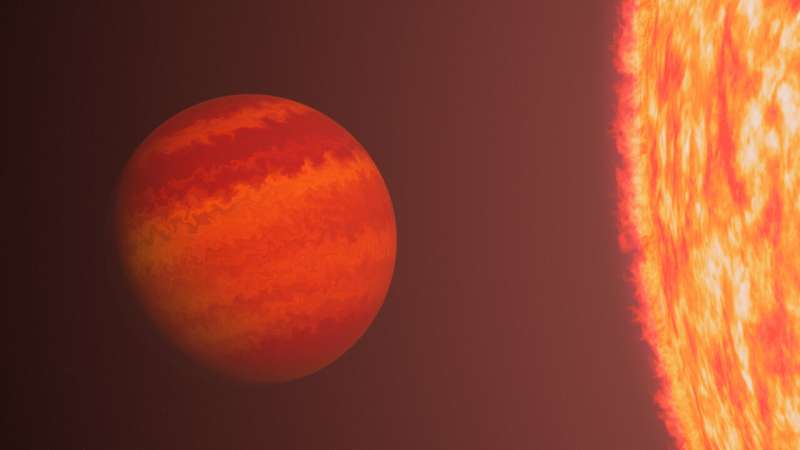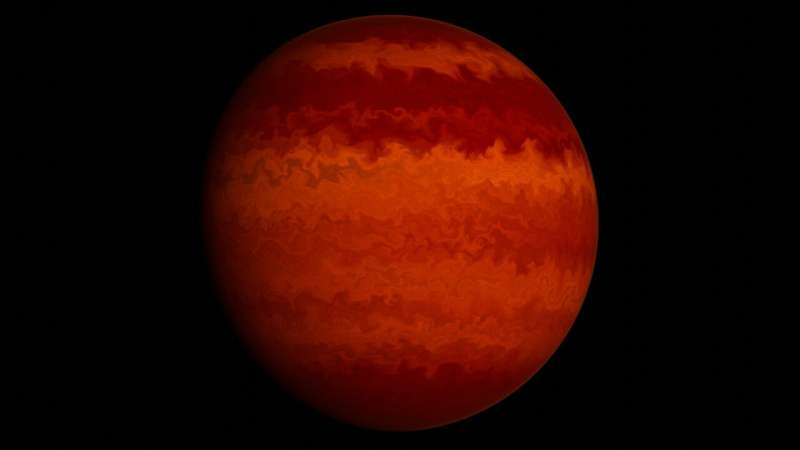This article has been reviewed according to Science X's editorial process and policies. Editors have highlighted the following attributes while ensuring the content's credibility:
fact-checked
peer-reviewed publication
trusted source
proofread
'Weird' new planet retains atmosphere despite nearby star's relentless radiation

A rare exoplanet that should have been stripped down to bare rock by its nearby host star's intense radiation somehow grew a puffy atmosphere instead—the latest in a string of discoveries forcing scientists to rethink theories about how planets age and die in extreme environments.
Nicknamed "Phoenix" for its ability to survive its red giant star's radiant energy, the newly discovered planet illustrates the vast diversity of solar systems and the complexity of planetary evolution—especially at the end of stars' lives.
The findings are published in The Astronomical Journal.
"This planet isn't evolving the way we thought it would, it appears to have a much bigger, less dense atmosphere than we expected for these systems," said Sam Grunblatt, a Johns Hopkins University astrophysicist who led the research. "How it held on to that atmosphere despite being so close to such a large host star is the big question."
The new planet belongs to a category of rare worlds called "hot Neptunes" because they share many similarities with the solar system's outermost, frozen giant despite being far closer to their host stars and far hotter.
Officially named TIC365102760 b, the latest puffy planet is surprisingly smaller, older, and hotter than scientists thought possible. It is 6.2 times bigger than Earth, completes an orbit around its parent star every 4.2 days, and is about six times closer to its star than Mercury is to the sun.
Because of Phoenix's age and scorching temperatures, coupled with its unexpectedly low density, the process of stripping its atmosphere must have occurred at a slower pace than scientists thought possible, the scientists concluded. They also estimated that the planet is 60 times less dense than the densest "hot Neptune" discovered to date, and that it won't survive more than 100 million years before it begins dying by spiraling into its giant star.
"It's the smallest planet we've ever found around one of these red giants, and probably the lowest mass planet orbiting a [red] giant star we've ever seen," Grunblatt said. "That's why it looks really weird. We don't know why it still has an atmosphere when other 'hot Neptunes' that are much smaller and much denser seem to be losing their atmospheres in much less extreme environments."

Grunblatt and his team were able to gain such insights by devising a new method for fine-tuning data from NASA's Transiting Exoplanet Survey Satellite. The satellite's telescope can spot low-density planets as they dim the brightness of their host stars when passing in front of them. But Grunblatt's team filtered out unwanted light in the images and then combined them with additional measurements from the W.M. Keck Observatory on Hawaii's Maunakea volcano, a facility that tracks the tiny wobbles of stars caused by their orbiting planets.
The findings could help scientists better understand how atmospheres like Earth's might evolve, Grunblatt said. Scientists predict that in a few billion years the sun will expand into a red giant star that will swell up and engulf Earth and the other inner planets.
"We don't understand the late-stage evolution of planetary systems very well," Grunblatt said. "This is telling us that maybe Earth's atmosphere won't evolve exactly how we thought it would."
Puffy planets are often composed of gases, ice, or other lighter materials that make them overall less dense than any planet in the solar system. They are so rare that scientists believe only about 1% of stars have them.
Exoplanets like Phoenix are not as commonly discovered because their smaller sizes make them harder to spot than bigger, denser ones, Grunblatt said. That's why his team is searching for more of these smaller worlds. They already have found a dozen potential candidates with their new technique.
"We still have a long way to go in understanding how planetary atmospheres evolve over time," Grunblatt said.
More information: TESS Giants Transiting Giants. IV. A low-density hot Neptune orbiting a red giant star, The Astrophysical Journal (2024). DOI: 10.3847/1538-3881/ad4149
Journal information: Astrophysical Journal , Astronomical Journal
Provided by Johns Hopkins University



















